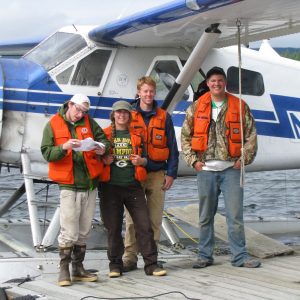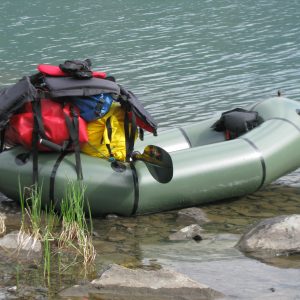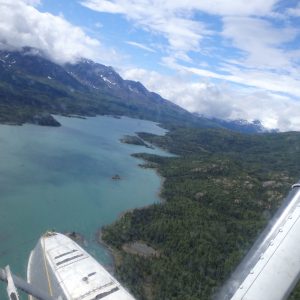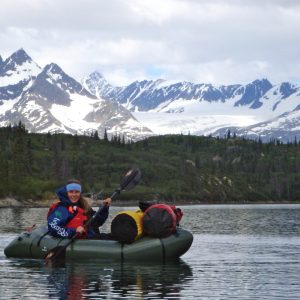My work out here in Alaska has been unforgettable to say the least! I just returned from a week long pack rafting trip on Tebay Lakes. The 3 lakes are only accessible by floatplane, which we got to fly in on…we were surveying the lake for an aquatic invasive Elodea canadensis (Canadian Waterweed). It is suspected that this weed is transported by float planes, and we were surveying this particular lake because it gets a lot of float plane traffic from Cordova (a place where there is known infestations of Elodea in its lakes). The first documented encounter with this invasive aquatic plant took place in 2010 in Fairbanks and this is the first aquatic freshwater invasive plant species that has been confirmed in Alaska. Here is a section of an article I helped to write that was published in the local newspaper:
” As with most invasive plant species, Elodea was brought over for decoration. Its bright green leaves, hearty stem, and long roots make it an attractive specimen for aquariums. U.S. Forest Service ecologist, Trish Wurtz said, “It’s almost guaranteed,” that someone dumped it into the Chena slough from an aquarium sometime in the past 10 years. Wurtz observed, “A bunch of red clay balls” (commonly found in aquaria) in the silt underneath a bridge in the slough.
Elodea reproduces asexually from plant parts. In the fall, leafy stalks detach from a parent plant, float away, root, and start new plants. The smallest fragment of Elodea can survive the frozen waters of Alaskan winters, wait patiently until it thaws, and float downstream until it finds a suitable place for it to grow. Elodea prefers slow moving water with thick sediment. Once it has settled into a spot, Elodea grows rapidly where it accumulates into a tangled mass.
What does this mean for Alaskans? Like many invasive species, Elodea knows no boundaries. Once established in an area, it can quickly take over. Elodea can easily cling to rudders and floats, as well as boat propellers, only to be deposited at the next water body. Elodea can reduce water flow and water quality, out-compete native aquatic plants, lower property values, make waters unusable for recreation and degrade fish spawning habitats. On a grander scale, Elodea can make a huge impact on two large Alaskan industries: sport fishing and commercial salmon harvesting. According to estimates by the Alaska Department of Fish and Game, Elodea could make a dent of $350,000 loss per year for both these industries combined.”
After surveying the lakes, we found no Elodea but took samples of a few aquatic plants to get identified. Alaska has really proven itself to be a rugged place, as I got to experience bush-whacking up creeks, cooking fresh trout over the fire and camping all along the way, bringing only what I needed and could fit in my two dry bags that were strapped onto my pack raft… Incredible experience…annnnd THIS is my job!
Until next time,
Morgan, Exotic Plant Management Team, Wrangell-St. Elias National Park
- A weeks supply of gear all loaded on my pack raft
- Lower Tebay Lake from the floatplane




